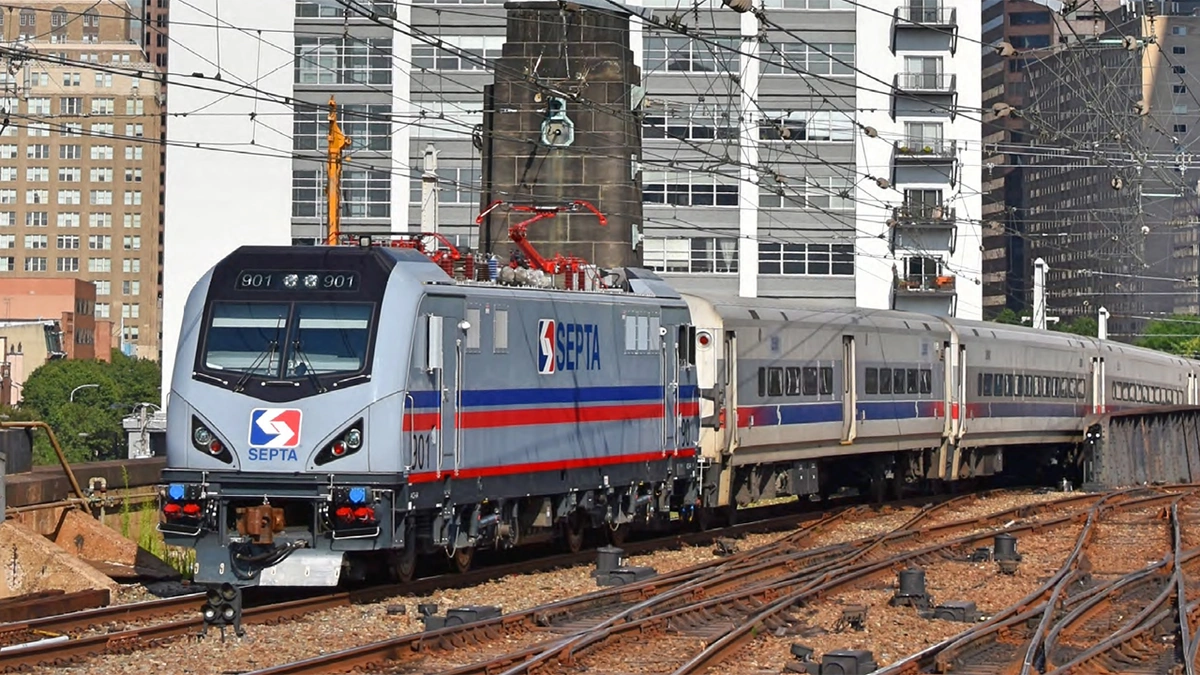Okay, let’s grab a coffee and talk about something you’ve probably never thought about: the public transit system in Philadelphia, USA. Stick with me. I know what you’re thinking. “Why on earth would I, sitting in Bengaluru or Delhi, care about a creaky old American train system?”
Here’s the thing. We’re incredibly proud of our metros in India, and we should be. They’re shiny, they’re clean, they’re a symbol of our modernizing cities. The Delhi Metro is a world-class marvel, and the network expanding across cities like Mumbai, Chennai, and Hyderabad is genuinely impressive. They are in their golden age.
But what happens when the shine wears off? What happens in 40, 50, or 70 years when the systems are old, the costs have skyrocketed, and the political will has moved on to the next big thing?
For a glimpse into that future, we need to look at SEPTA .
And trust me, it’s a lesson we need to learn now, before it’s too late.
So, What Exactly is SEPTA? (And Why It’s a Crystal Ball for Our Cities)

SEPTA stands for the Southeastern Pennsylvania Transportation Authority. It’s not just a metro; it’s a sprawling, complicated beast of a system. Think subways that have been running for over a century, vintage streetcars (trolleys) that look like they’re out of a history book, regional rail lines stretching into the suburbs, and a massive fleet of buses. It was all stitched together over decades, and frankly, you can see the seams.
It’s the sixth-largest public transit system in the United States, and it is the polar opposite of our new, centrally planned metro networks. And that’s precisely what makes it such a fascinating and terrifying case study for urban infrastructure planners in India.
Our metros are young. They were built with modern technology and a unified vision. SEPTA is what happens when a system has to survive generations of political changes, economic downturns, and technological shifts. It’s a grizzled veteran, covered in scars. And each scar tells a story a warning about the challenges that lie ahead for our own beloved metros. What we see in SEPTA today could be a preview of the Delhi Metro challenges of 2070.
The ‘Fiscal Cliff’ | A Terrifying Warning Bell for Indian Metros

Right now, SEPTA is staring down the barrel of what they call a “fiscal cliff.” A huge chunk of its funding came from federal aid during the pandemic, and that money is about to run out. They are facing a budget shortfall of a staggering $240 million starting next year. The result? They’re talking about massive fare hikes and service cuts that could cripple transportation for millions of people.
Let’s be honest, this sounds vaguely familiar, doesn’t it?
In India, we love our low metro fares. A ride is affordable, subsidized, and seen as a public service. But the question we’re not asking loudly enough is: is this model sustainable in the long run? Most Indian metros are heavily reliant on government grants and loans for their initial construction and are not operationally profitable. According to official reports, almost all major metro systems in India are running at a loss, even before accounting for massive depreciation and debt costs.
What SEPTA’s crisis shows us is that over-reliance on a single source of funding whether it’s passenger fares or government handouts is a recipe for disaster. When that source dries up, the entire system is at risk. This is a critical lesson for the future of public transportation in India . We need to be aggressively exploring diversified revenue streams now: think real estate development around stations (like in Hong Kong), advertising, and dedicated carbon taxes. Otherwise, our metros could face their own fiscal cliff in a few decades, forcing a terrible choice between unaffordable tickets and a degrading system.
The Integration Nightmare | Why a Common Card Isn’t Enough

India is pushing for the “One Nation, One Card” system, a fantastic initiative to create a seamless payment experience across different modes of transport. It’s a great goal. But SEPTA teaches us that true integration is so much more complicated than just a smart card. For years, they’ve struggled to get their own unified payment system, the SEPTA Key, to work smoothly across their ancient trolleys, modern trains, and buses.
But the real challenge is physical and operational. How do you ensure a smooth transfer between a 100-year-old subway line and a brand-new bus route? How do you sync timetables when one part of the system is constantly breaking down due to old age?
As our own metro networks expand, they will inevitably start to connect with older, existing infrastructure like suburban railways or city bus networks. We can’t just assume a common payment card will solve the problem. Real integration the kind that makes a passenger’s journey genuinely seamless requires deep, often difficult, coordination of schedules, station design, and information systems. SEPTA shows us that ignoring this leads to a fragmented and frustrating experience for commuters, no matter how easy it is to pay.
But It’s Not All Doom and Gloom | The Lessons in Grit

I know I’ve painted a bleak picture. But here’s the other side of the coin: despite everything, SEPTA works. It moves millions of people every week, often against incredible odds. And in its struggle, there are powerful lessons in resilience.
One of its biggest strengths is its sheer reach. It connects the dense urban core with far-flung suburbs, providing a lifeline for people from all economic backgrounds. This is a crucial reminder for our smart cities India initiatives. It’s not enough to build a fancy metro that only serves the central business district. A truly great transit system must serve the entire metropolitan region, including the less glamorous, often-neglected peripheries.
The system has also been forced to become incredibly resourceful. They are experts at keeping ancient vehicles running and patching up century-old tunnels. While we should aim for better, this grit is a testament to the fundamental human need for mobility. It shows that when a transit system becomes embedded in the life of a city, people will fight to keep it alive.
Thinking about a different kind of mystery? Check out the unsolved yogurt shop murders case.
The journey of SEPTA , with its messy history and uncertain future, is one of the most important stories our city planners can study. It’s a living laboratory of what can go wrong and a testament to the enduring power of public transit. Or, for something completely different, see how Kate Middleton blonde hair has been trending.
Frequently Asked Questions (FAQ)
What is the biggest difference between SEPTA and something like the Delhi Metro?
The biggest difference is age and uniformity. The Delhi Metro is a modern, relatively young, and technologically unified system. SEPTA is a much older amalgamation of different types of transit (subway, trolley, regional rail) built over 100+ years, leading to massive challenges in maintenance and integration.
Is public transport profitable anywhere in the world?
Operationally, yes, a few systems like the MTR in Hong Kong and SMRT in Singapore are profitable. However, they achieve this through extensive real estate holdings and retail operations around their stations a model called “Rail plus Property.” Most systems worldwide, including in the US and Europe, require significant public subsidies to operate.
What can I, as a citizen, do to support better public transport in India?
Use it! High ridership is the best argument for more funding and expansion. Beyond that, participate in public consultations, provide feedback to your local metro authority, and advocate for policies that prioritize public transit, pedestrian-friendly streets, and better last-mile connectivity.
Why is maintenance so expensive for metro systems?
Maintenance is incredibly complex. It involves everything from daily cleaning and safety checks to massive, long-term overhauls of tracks, signaling systems, and rolling stock (the trains themselves). As a system ages, the cost of replacing these critical components, many of which are hidden underground, increases exponentially.
Are Indian metros also facing funding issues?
Yes. While they receive initial funding for construction, almost all Indian metros run at an operational loss. Their revenue from fares doesn’t cover their day-to-day running costs, let alone long-term debt and depreciation. This is a major concern for their future financial health.
So, the next time you step onto a spotless metro platform in India, take a moment to appreciate it. But also, think of the long road ahead. The challenge isn’t just building these incredible systems; it’s ensuring they thrive for the next hundred years. And the messy, complicated, and crisis-ridden story of SEPTA might just hold the key to that future. It’s a reminder that foresight is cheaper than hindsight, especially when it comes to the lifelines of our cities.




